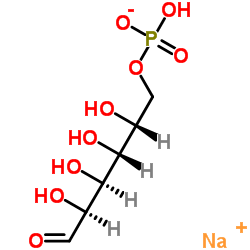Extensive mannose phosphorylation on leukemia inhibitory factor (LIF) controls its extracellular levels by multiple mechanisms.
Jarrod Barnes, Jae-Min Lim, Anne Godard, Frédéric Blanchard, Lance Wells, Richard Steet
Index: J. Biol. Chem. 286(28) , 24855-64, (2011)
Full Text: HTML
Abstract
In addition to soluble acid hydrolases, many nonlysosomal proteins have been shown to bear mannose 6-phosphate (Man-6-P) residues. Quantification of the extent of mannose phosphorylation and the relevance to physiological function, however, remain poorly defined. In this study, we investigated the mannose phosphorylation status of leukemia inhibitory factor (LIF), a previously identified high affinity ligand for the cation-independent mannose 6-phosphate receptor (CI-MPR), and we analyzed the effects of this modification on its secretion and uptake in cultured cells. When media from LIF-overexpressing cells were fractionated using a CI-MPR affinity column, 35-45% of the total LIF molecules were bound and specifically eluted with free Man-6-P thus confirming LIF as a bona fide Man-6-P-modified protein. Surprisingly, mass spectrometric analysis of LIF glycopeptides enriched on the CI-MPR column revealed that all six N-glycan sites could be Man-6-P-modified. The relative utilization of these sites, however, was not uniform. Analysis of glycan-deleted LIF mutants demonstrated that loss of glycans bearing the majority of Man-6-P residues leads to higher steady-state levels of secreted LIF. Using mouse embryonic stem cells, we showed that the mannose phosphorylation of LIF mediates its internalization thereby reducing extracellular levels and stimulating embryonic stem cell differentiation. Finally, immunofluorescence experiments indicate that LIF is targeted directly to lysosomes following its biosynthesis, providing another mechanism whereby mannose phosphorylation serves to control extracellular levels of LIF. Failure to modify LIF in the context of mucolipidosis II and its subsequent accumulation in the extracellular space may have important implications for disease pathogenesis.
Related Compounds
| Structure | Name/CAS No. | Molecular Formula | Articles |
|---|---|---|---|
 |
Sodium (2R,3R,4S,5S)-2,3,4,5-tetrahydroxy-6-oxohexyl hydrogenphosphate
CAS:70442-25-0 |
C6H12NaO9P |
|
Biomineralization in diatoms-phosphorylated saccharides are ...
2013-01-10 [Carbohydr. Res. 365 , 52-60, (2013)] |
|
The DMAP interaction domain of UDP-GlcNAc:lysosomal enzyme N...
2013-06-18 [Proc. Natl. Acad. Sci. U. S. A. 110(25) , 10246-51, (2013)] |
|
Mannose-6-phosphate regulates destruction of lipid-linked ol...
2011-09-01 [Mol. Biol. Cell 22(17) , 2994-3009, (2011)] |
|
In vivo targeting of alveolar macrophages via RAFT-based gly...
2012-10-01 [Biomaterials , (2012)] |
|
Mannose 6 phosphorylation of lysosomal enzymes controls B ce...
2015-01-19 [J. Cell Biol. 208(2) , 171-80, (2015)] |